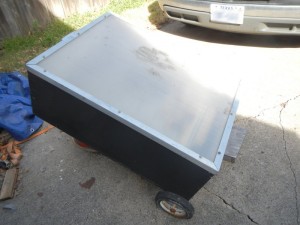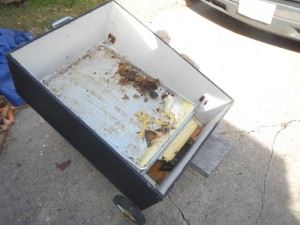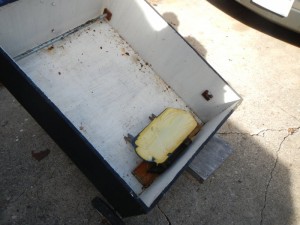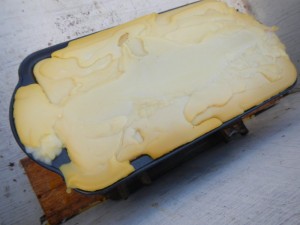To the untrained eye – this may simply look like an innocent portable outdoor solar-powered skylight. However, to the trained and experienced eye – a solar wax melter is seen.
 Take off the lid, and you may see the remnants of honeycomb that has been cleaned of it’s honey by honeybees – and then placed onto the tray in this box to melt, filter through a cloth, then drip into a pan below.
Take off the lid, and you may see the remnants of honeycomb that has been cleaned of it’s honey by honeybees – and then placed onto the tray in this box to melt, filter through a cloth, then drip into a pan below.
Today’s (2-16-2016) temperature in my area is only 71 deg. F – yet the temperature in the solar wax melting box reached temperatures over 140 deg. F (which is the approximate melting point of beeswax).
I generally filter my wax in this manner at least 3 times. The wax can range in color from a pure white (with brand-spanking-new wax) to a bright yellow, or a light brown for old brood-comb.
This process uses a cloth filter to catch the solids from the melted wax. Afterwards the leftover comb remnants that are non-wax (i.e. the brood casings from the cells) can be used in swarm traps to attract swarms to a specific swarm-trap-box, used as a fire-starter for campfires, or can simply be added to my garden to compost into the soil and be recycled by the Earth.
 Cookie tray with comb remnants on it. A hole is near the bottom lip of the tray – with a filter around the hole.
Cookie tray with comb remnants on it. A hole is near the bottom lip of the tray – with a filter around the hole.
 Underneath the tray is a bread loaf pan that catches the liquid wax as it drips through the filter. It collects in the pan, and when the sun goes down, it cools slowly, and the loaf of wax can either go through the process again to be further filtered… or can be used for projects.
Underneath the tray is a bread loaf pan that catches the liquid wax as it drips through the filter. It collects in the pan, and when the sun goes down, it cools slowly, and the loaf of wax can either go through the process again to be further filtered… or can be used for projects.
 This loaf-pan almost overflowed into the wax melting box. I checked on it just in time to keep a mess from happening. A new drip-pan was placed underneath, and more wax is ready to melt and filter. After this block of wax cools off, I will melt it over a double boiler, then pour onto smaller molds for easy use in projects.
This loaf-pan almost overflowed into the wax melting box. I checked on it just in time to keep a mess from happening. A new drip-pan was placed underneath, and more wax is ready to melt and filter. After this block of wax cools off, I will melt it over a double boiler, then pour onto smaller molds for easy use in projects.

Leave a Reply
You must be logged in to post a comment.